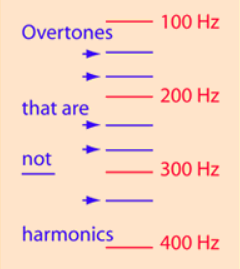문서의 이전 판입니다!
오버톤
Overtone
배음은 기음의 정수배에 대항하는 주파수 성분들이지만, 오버톤은 기음의 정수배가 아닌 주파수 성분들을 말한다. 음정을 가진 악기들의 경우에는 기음과 배음의 조합으로 음색을 표현하고 오버톤이 거의 없지만, 음정을 가지지 않은 음색1)은 기음과 배음 및 오버톤으로 이루어져 있고 오버톤이 상대적으로 크기 때문에 음정이 잘 분간되지 않는 소리로 표현되는 경향이 있다.
예를 들면 드럼과 같은 타악기의 음색에는 기음과 배음도 있지만, 그보다도 상당 수 오버톤이 많이 포함되어 있기 때문에, 드럼의 음색에 매우 큰 영향을 미친다.
음악과 음향학의 맥락에서 “오버톤“과 “배음“이라는 용어는 미묘한 차이가 있음에도 불구하고 종종 같은 의미로 사용됩니다.
Harmonics are frequency components that correspond to integer multiples of the fundamental, while overtones refer to frequency components that are not integer multiples of the fundamental. In the case of pitched instruments, the timbre is expressed through a combination of the fundamental and harmonics, with relatively few overtones. However, for unpitched sounds, the timbre is composed of the fundamental, harmonics, and overtones, and due to the relatively significant presence of overtones, it often results in a sound where the pitch is not easily distinguishable.
For example, in the case of percussion instruments like drums, the timbre consists of both the fundamental and harmonics, but it also includes a substantial number of overtones. This is why overtones have a significant influence on the timbre of drums.
Please note that in the context of music and acoustics, the terms “overtones” and “harmonics” are often used interchangeably, even though there is a subtle distinction between them.
[공지]회원 가입 방법
[공지]글 작성 및 수정 방법

